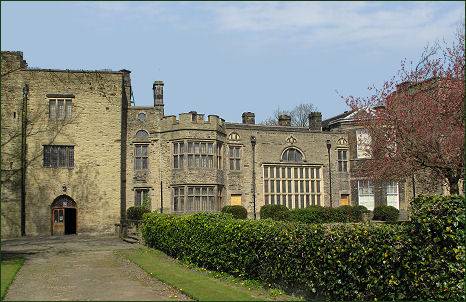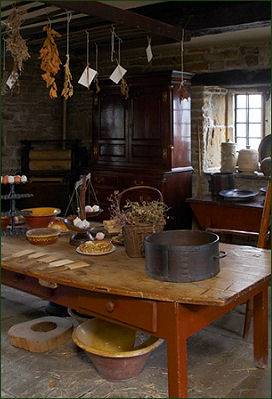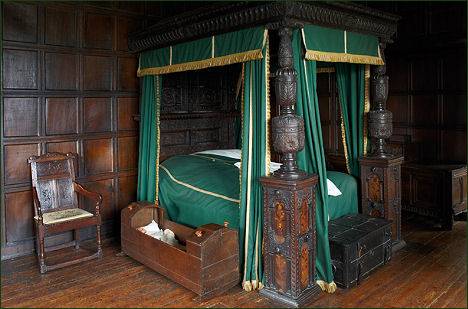Bolling Hall, Bradford
OS grid reference:-
 Imposing Bolling Hall is one of the oldest buildings in the West Yorkshire town of Bradford.
Imposing Bolling Hall is one of the oldest buildings in the West Yorkshire town of Bradford.
The earliest sections of the building date back to the fourteenth century and it has been interpreted as a pele tower, although Bradford is somewhat outside the usual geographical area for these defensive structures.
 The building stands about a mile from the centre of Bradford and is situated in a quiet garden, opposite Bowling Park on the Bradford - Bierley road. It is currently used as a museum and education centre. Prior to the Industrial Revolution, Bradford was a small town and as it lay in a basin was difficult to defend, the hall was built on a hill just above the town..
The building stands about a mile from the centre of Bradford and is situated in a quiet garden, opposite Bowling Park on the Bradford - Bierley road. It is currently used as a museum and education centre. Prior to the Industrial Revolution, Bradford was a small town and as it lay in a basin was difficult to defend, the hall was built on a hill just above the town..
The first recored reference to the Manor of Bolling occurs in the Domesday Book of 1086, where it is mentioned as Bollinc, and was at that time owned by a man named Sindi, it was then worth five shillings annual rent (25p in today's money).
The manor then came under the control of Ilbert de Lacy, Lord of Pontefract, a Norman baron originating from Lassy, Calvados, who as reward for fighting at the Battle of Hastings was granted large estates in the west of Yorkshire by William the Conqueror. Ilbert was a major participant in the Harrying of the North (1069-70) during which large-scale destruction took place which resulted in the relative "pacification" of the local population and the replacement of local Anglo-Danish lords with Normans. He also took part in the Norman invasion of Ireland. The Honour of Pontefract was maintained by Ilbert's direct male descendants for the next three generations until 1192. It continued in the female line until 1348. However, no record survives to reveal how long the de Laci family remained in possession of Bolling Hall.
 By 1316 the manor was recorded as being owned by William Bolling, during the War of the Roses, his descendant Robert Bolling temporarily lost Bolling Hall, his land and manor houses were forfeited to the crown, for fighting on the side of the Lancastrians, against the Yorkist king, Edward IV. Robert Bolling lived in impoverished circumstances. In 1472 he gained the return of his estates, claiming that he had fought in the battle against his will. Robert Bolling gained the support of the King's brother, Richard, Duke of Gloucester, later to be crowned as King Richard III.
By 1316 the manor was recorded as being owned by William Bolling, during the War of the Roses, his descendant Robert Bolling temporarily lost Bolling Hall, his land and manor houses were forfeited to the crown, for fighting on the side of the Lancastrians, against the Yorkist king, Edward IV. Robert Bolling lived in impoverished circumstances. In 1472 he gained the return of his estates, claiming that he had fought in the battle against his will. Robert Bolling gained the support of the King's brother, Richard, Duke of Gloucester, later to be crowned as King Richard III.
The Bolling family owned the estate until the late fifteenth century. Records reveal that the family increased their wealth and accumulation of land during the thirteenth and fourteenth centuries, and by the fifteenth century had become an important family in the West Riding of Yorkshire.
Eventually ownership of Bolling Hall passes to the Tempest family, through the 1497 marriage of Richard Tempest to Rosamund Bolling, the only daughter and heiress of Tristram Bolling. Richard Tempest died in prison in 1537, he had taken part in the Pilgrimage of Grace, a popular rising in Yorkshire in the autumn of 1536 against Henry VIII's break with the Roman Catholic Church, the Dissolution of the Monasteries and the policies of the King's chief minister, Thomas Cromwell. Richard died in prison whilst awaiting trial. Rosamund Tempest carried on running of the estate until her death in 1553. The Tempest family held the estate until 1649. The estate changed hands several times thereafter until eventually it was let to several tenants until being presented to Bradford Corporation in 1912. It was opened as a museum three years later.
During the Civil War, the second siege of Bradford occured in 1643, when the Bolling Hall, then owned by another Richard Tempest, served as a Royalist base. On this occasion the Royalists captured the town, which had strong Parliamentarian sympathies, and it was thought that the victors would put the inhabitants would be slain. There is a legend that a ghost appeared in the bedroom where the Royalist commander Earl of Newcastle was staying, wringing its hands it instructed him to "Pity poor Bradford". There is usually material on display relating to the English Civil War including a death mask of Oliver Cromwell.
In the eighteenth century parts of the house were modernised by the architect John Carr, following a fire. Bolling Hall is a rambling mixture of styles, with rooms furnished and decorated to give an accurate taste of life at different periods of the house's history, and the fascinating furniture on display includes a superb bed made for Harewood House by Thomas Chippendale.
Directions
Bolling Hall situated on Bowling Hall Road one mile south of Bradford City Centre and is signposted with heritage 'brown signs' from A650 Wakefield Road.
Historic Buildings of Yorkshire
